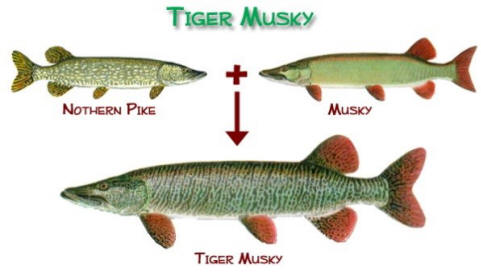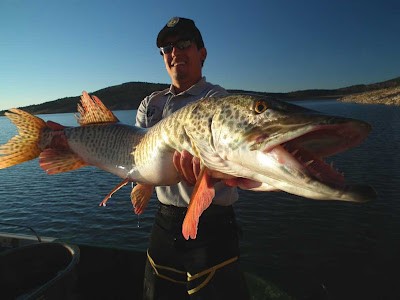Comparisons to Parent Species
Tiger Muskies are the sterile spawn
of
Esox masquinongy and
Esox lucius or better known as the
muskellunge and the northern pike. There are many articles that
talk about the similarities and
 differences of the tiger muskies
in comparison to its two parent species. In a Canadian journal
of aquatic sciences they compare overall growth and growth
speeds as juveniles and adults, they also compare survival
rates, and diets. In another article they compared morphology of
the three escoid relatives.
differences of the tiger muskies
in comparison to its two parent species. In a Canadian journal
of aquatic sciences they compare overall growth and growth
speeds as juveniles and adults, they also compare survival
rates, and diets. In another article they compared morphology of
the three escoid relatives.
Figure 7. Parent species of the tiger musky. Photo complements of ultimatemuskyguide.com
According to the Fish Introduction
Proposal Phillips Reservoir Tiger Muskie there are four major
morphological distinctions between the pure muskellunge, the
northern pike, and the tiger musky. The first and most obvious of
the four is the scale pattern. Tiger muskies have dark vertical
stripes going down the sides of their sleek torpedo like bodies
similar to a tiger hence why they are called tiger muskies. Pure
muskies can vary from elongated spots to no pattern at all, while
northern pike on the other hand have distinct spotted patterns. The
next morphological difference can be seen in the caudal fins (aka)
tail fins, and the belly fins. For northern pike and tiger muskies the
belly and caudal fins are rounded while in the pure musky they are
pointed. Another difference can be found by looking at the scales on
the cheek. Cheeks on pure muskies are only scaled on the upper half
while in pike the entire cheek is covered. Tiger muskies have gained
apiece from each parent; three fourths of its cheek is covered in
scales. The last major morphological difference and hardest to
identify are the number of mandibular pores on each of these three
escoids. Northern pike have 5 mandibular pores, pure muskies have 6
to 9 mandibular pores, and again tiger muskies inherit a little from
both parents giving it 5 to 8 pores.
In one experiment northern pike, pure
muskies, and tiger muskies were observed for five years and were
compared to each other by growth, survival and diet
(Wahl and Stein
1993). In all three species growth increased on average at a linear
rate, meaning each type of fish grew at a consistent rate per year
for five years (Wahl and Stein 1993). In juvenile stages all three
escoids grew at similar speeds and size for length but in weight
pike were typically the fastest growing juveniles, followed by the
tiger musky, and then the pure musky (Wahl and Stein 1993). With
that being said at an adult age it is. generally completely flipped;
muskies grow the fastest and biggest, followed again by tiger
muskies, and then pike (Wahl and Stein 1993). Survival rates were
also measured in each species. Results show in the given environment
pike typically survived the most often up to the age of four,
followed by pure muskies, and bringing up the rear are tiger muskies
(Wahl and Stein 1993). The last comparison made in this
experiment was on diet content which all turned out to be very
similar. Most popular of bait fish was gizzard shad, then it was
centrarchids and lastly
cyprinids (Wahl and Stein 1993).
muskies were observed for five years and were
compared to each other by growth, survival and diet
(Wahl and Stein
1993). In all three species growth increased on average at a linear
rate, meaning each type of fish grew at a consistent rate per year
for five years (Wahl and Stein 1993). In juvenile stages all three
escoids grew at similar speeds and size for length but in weight
pike were typically the fastest growing juveniles, followed by the
tiger musky, and then the pure musky (Wahl and Stein 1993). With
that being said at an adult age it is. generally completely flipped;
muskies grow the fastest and biggest, followed again by tiger
muskies, and then pike (Wahl and Stein 1993). Survival rates were
also measured in each species. Results show in the given environment
pike typically survived the most often up to the age of four,
followed by pure muskies, and bringing up the rear are tiger muskies
(Wahl and Stein 1993). The last comparison made in this
experiment was on diet content which all turned out to be very
similar. Most popular of bait fish was gizzard shad, then it was
centrarchids and lastly
cyprinids (Wahl and Stein 1993).
To continue to the next page press Predation, to go back to the previous page press Angling, or you can check out where we got the information by pressing References. Finally to go back to our main page press Home.
